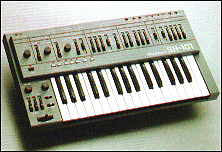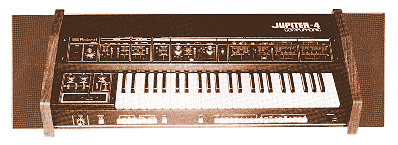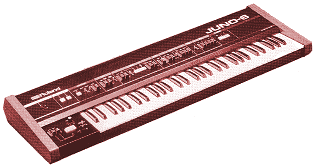
|
Part One of Newslink's Advanced Synthesizer Course
by David Marshall
Newslink's two-part introduction to analogue
synthesis - Basic Synthesis - concentrated on the basic elements of
sound synthesis. The model was a monophonic system using a single oscillator.
Beyond Basic Synthesis covers some of the historical developments
from this starting point: greater complexity of sound; polyphonic synthesizers
and the rise of digital technology; and the introduction of preset and
programmable synths.
 |
Complex waveforms
The basic waveform can be modified in pitch (via the keyboard), in harmonic
content (via the Filter section and Resonance or Emphasis control) and in
amplitude or volume. Further alteration can be introduced via an Envelope
Generator (which alters any or all of these elements with respect to time)
and by use of controls such as Pitch Bend etc.
To create more complex tones, multiple oscillator systems can be used, the
signals from these oscillators being mixed together in a straightforward
audio mixer before passing on to the filter and amplifier banks for further
treatment. Other variations to the basic waveform include modulation of Pitch,
Amplifier, Filter and Pulse Width by additional 'Low Frequency Oscillators,
to produce Vibrato, Tremolo, Wah-Wah and Chorus effects.
| mp3 118K |
More extreme variations are possible when
multi-oscillator synthesizers modulate the waveform through interaction.
The most commonly used method is Ring Modulation. A simple Ring Modulator
involves two input frequencies provided by two oscillators, and a single
output. The Ring Modulator (RM) provides a 'sum and difference' compound
of the two inputs. For example if the two oscillators are producing frequencies
of 440Hz (A4) and 660Hz (E5) then the output of the RM will produce frequencies
of 660 - 440 = 220Hz (A3) and 660 + 440 = 1100Hz (C#6). The output should
not include the original frequencies.
In this example the difference (220Hz) provides
the fundamental tone while the sum (1100Hz) is an overtone equivalent to
the 5th Harmonic; both frequencies lie within a harmonic series and the result
does not sound particularly electronic. By varying the input frequencies
non-harmonic relationships can be achieved. The aural effect of this is to
produce bell-like and metallic effects, and this was the main usage of Ring
Modulation in early synthesis.
For more outrageous effects the input signals
can also be complex tones rather than simple sine waves. With the rise in
popularity of metallic sounds in the last few years Ring Modulation, which
lost its appeal for a while and disappeared as an option on many synths,
is making a comeback (eg Roland's LA Synthesis method).
Early polyphony
Early synthesizers, such as the MiniMoog, the ARP Odyssey and the Roland
SH-101, were monophonic, that is, they could only play one note at a time,
like a flute or a human voice. To increase the number of notes available
at one time, and so produce chords, requires additional instruments. Classical
composers write for flute sections or choirs, naturally incurring the expense
of extra manpower, the same applies to synthesizers. Although only one keyboard
and one player is required, a polyphonic analogue synthesizer needs an extra
Oscillator, Filter and Amplifier for each additional note of polyphony. Early
polyphonic synthesizers, such as the Roland Jupiter 4 and the PolyMoog Synth,
limited the number of available polyphonic notes to four, six or eight to
keep costs relatively low; even so they were luxury items. When more notes
are played than can be handled by the instrument, systems like First Note
and Last Note Priority operate - the names referring to the method by which
a synthesizer decides which notes to sound when the number of keys depressed
exceeds its polyphony.
Digital oscillators
Analogue 'Voltage Controlled Oscillators' (VCOs) have some fundamental problems.
They are liable to drift out of tune, requiring periodic retuning by an engineer;
temporary tuning drift is caused by temperature fluctuations - synthesizers
with VCOs must be switched on well before a gig (especially in an open-air
venue) in order for them to be in tune by the time it starts. Space is also
a constraint. Analogue circuitry is relatively bulky and a polyphonic synthesizer
requires several voice modules - the result is an increase in size and weight.
 |
With the advent of cheaper digital technology,
and the miniaturisation made possible by the micro-processor, the Digital
Oscillator was developed. As well as giving tuning stability, it is much
more space-effective. Its biggest advantage, however, is in cost. Using DCOs
(Digitally Controlled Oscillators) a 6-voice polyphonic synthesizer can be
produced for a price similar to that for a twin VCO model. DCOs are found
on synths such as Roland Junos and JXs and the Korg Poly 61.
Programmability
Look at a synthesizer today and compare it with a unit from the '60s or '70s
and the most striking physical change is the reduction in the number of front
panel controls. Early synthesizers, as well as being mostly monophonic and
analogue, were also known as 'fully variables'. Each parameter of the sound
(cut-off point, envelope etc) had a separate slider or switch control, allowing
the front panel setting to control the sound directly. This gave the user
precise and instant access to sound editing. However, to select another sound
could mean changing the entire panel setting - making this system difficult
for live use. Instruments that used this system included the Roland SH 101
and Juno 6, the MiniMoog and the Yamaha CS-01.
A step forward for the performer came with pre-set
machines. These could call up factory preset sounds (usually imitations of
acoustic instruments) at the touch of a button. With the advance in
microprocessors came the technology to create a cost-effective fully variable
machine with a user memory. These 'programmable synthesizers' first appeared
in the late 70s. They include such units as the Roland Jupiter 8 and Juno
60 the Oberheim and the Sequential Circuits Prophet 5.
In these synthesizers, when the 'write' button
is pressed the processor scans the front panel controls making a note of
the settings and storing these in the designated memory location. The user
can then recall at the push of a button or two any collection of panel settings.
An interesting 'half-way house' is the Yamaha CS-80. Its 'memory' consists
of four small panels, each a reproduction in miniature of the main control
panel. Four sounds can therefore be stored by setting these mini panels to
the desired values.
With all modern synthesizers the micro-processor
rules supreme. Gone are the one slider per parameter panels. Now all parameters
are controlled by a handful of sliders. The values of each parameter are
shown on an LCD or LED display and they can be stepped through using cursor
keys. While this makes the instrument more attractive (its clean lines
uncluttered by knobs and sliders) it causes undeniable problems for programmers.
The trend has been to drift steadily towards the use of factory presets and
a growth in third party software houses, who devise and market alternative
sounds to be accessed via RAM or ROM card slots on the synths.
 |
It is a constant source of complaint (especially
from those who have grown up with analogue synthesis) that players seem not
to program their own sounds any more - in fact a new breed of 'synthesizer
programmer' has sprung up to design sounds for busy session musicians.
Naturally there are two sides to the argument. Any manufacturer will point
out that costs of digital synthesizers are as low as they are only because
of the reduction in the numbers of knobs and sliders. Compare the weight
of a 61-note synth from the '70s with one from the late '80s and you will
realise another advantage of controls being software- as opposed to
hardware-based.
One solution to this problem may be in add-on
optional 'knobs and sliders' units for easier programming; the performer
can customise and store sounds before a gig and still have a stylish and
uncluttered stage set-up. Where this option is unavailable, software houses
have been quick to fill the gap with computer- based alternatives. Never
satisfied, of course, is the performer who wants the latest, cheapest and
most convenient technology plus comprehensive real-time editing.
So far these articles have been almost totally
concerned with Analogue or Analogue/ Digital Subtractive Synthesis. Beyond
Basic Synthesis Part 2, in your next edition of Roland Newslink, will examine
some different forms of synthesis, and explain how, combined with the principles
of analogue subtractive synthesis already discussed, they have resulted in
the current generation of synthesizers.
Basic Synthesis 1 | Basic Synthesis 2 | Advanced Synthesis 1 | Advanced Synthesis 2| Sampling 1 | Sampling 2
| Chaos | Quantum | Logic | Cosmos | Conscious | Belief | Elect. | Art | Chem. | Maths |